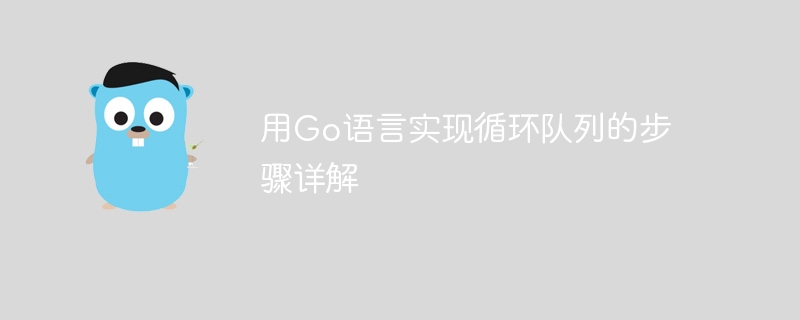Home >Backend Development >Golang >Detailed explanation of the steps to implement circular queue using Go language
Detailed explanation of the steps to implement circular queue using Go language
- 王林Original
- 2024-03-23 18:21:031006browse

Title: Detailed explanation of the steps to implement a circular queue in Go language
In computer science, the queue is a common data structure that follows the first-in-first-out (FIFO )the rules. Circular queues are a variant of queues that allow efficient use of fixed-size arrays to implement queue functionality. This article will detail the steps to implement a circular queue in the Go language and provide specific code examples.
What is a circular queue
The circular queue is a ring-shaped data structure that allows the function of a queue to be implemented in a fixed-size array and effectively utilizes memory space. In a circular queue, the head and tail of the queue are limited to both ends of the array, and the array can be reused through loops when the queue is full.
Steps to implement circular queue in Go language
- Define the circular queue structure
First, we need to define a structure to represent the circular queue. The structure needs to contain an array to store queue elements, as well as head and tail pointers and other information. The following is a code example for defining a circular queue structure in Go language:
type MyCircularQueue struct {
data []int
size int
front int
rear int
}- Initializing the circular queue
When initializing the circular queue, you need to specify the size of the queue and set the The head and tail pointers are initialized. The following is a code example for initializing a circular queue:
func Constructor(k int) MyCircularQueue {
return MyCircularQueue{
data: make([]int, k),
size: k,
front: 0,
rear: 0,
}
}- Implementing the enqueue operation
The enqueue operation is to add elements to the tail of the queue and update the tail pointer. When performing an enqueue operation, you need to consider the situation when the queue is full. The following is a code example for the enqueue operation:
func (this *MyCircularQueue) EnQueue(value int) bool {
if this.IsFull() {
return false
}
this.data[this.rear] = value
this.rear = (this.rear + 1) % this.size
return true
}- Implementing the dequeue operation
The dequeue operation is to remove the element from the head of the queue and update the head pointer . When performing dequeue operations, you need to consider the situation when the queue is empty. The following is a code example for the dequeue operation:
func (this *MyCircularQueue) DeQueue() bool {
if this.IsEmpty() {
return false
}
this.front = (this.front + 1) % this.size
return true
}- Implementing the method of determining whether the queue is empty and full
In addition to the enqueue and dequeue operations, You need to implement a method to determine whether the queue is empty and full. The following is a code example to determine whether the queue is empty and full:
func (this *MyCircularQueue) IsEmpty() bool {
return this.front == this.rear
}
func (this *MyCircularQueue) IsFull() bool {
return (this.rear+1)%this.size == this.front
}Summary
Through the above steps, the basic function of the circular queue is implemented in the Go language. Circular queues can effectively solve the space utilization problem of queues and improve the efficiency of data structures in certain scenarios. Readers can refer to the code examples provided in this article to implement more complex queue operations in the Go language and further apply them to actual projects.
The above is the detailed content of Detailed explanation of the steps to implement circular queue using Go language. For more information, please follow other related articles on the PHP Chinese website!

